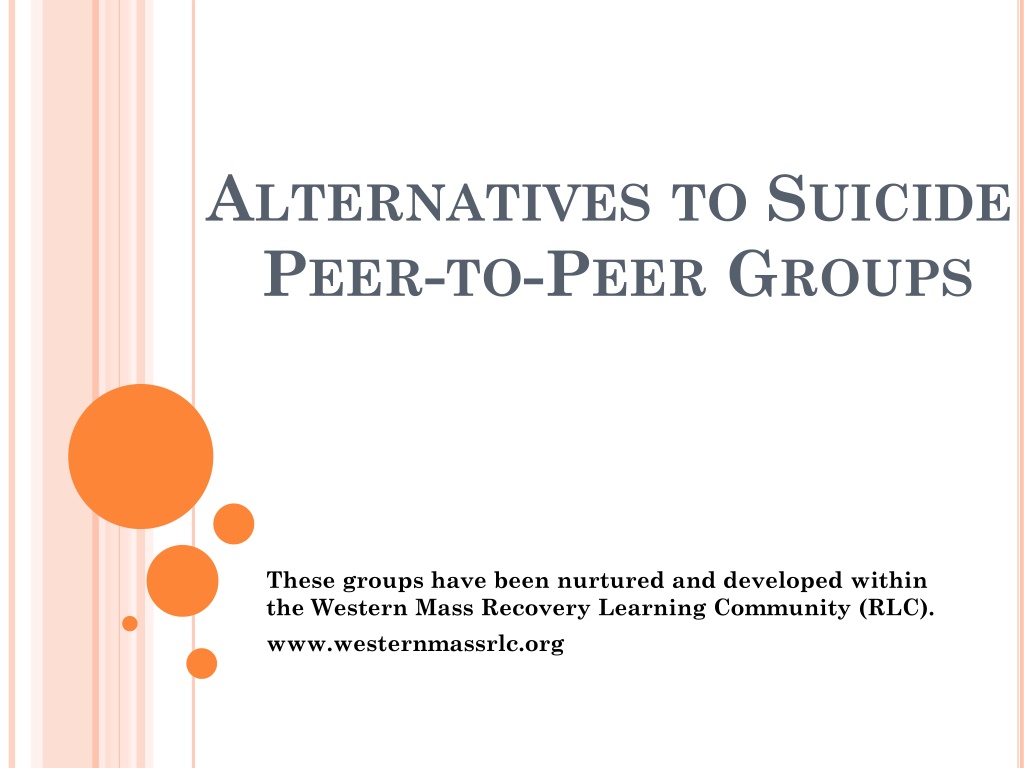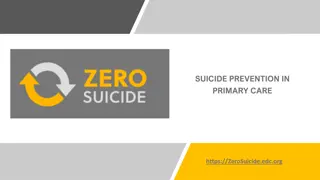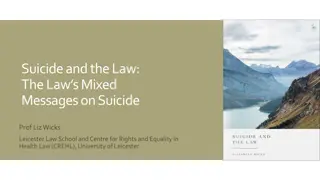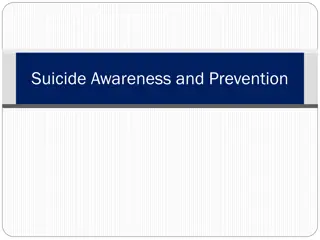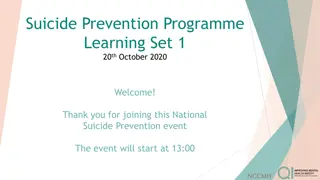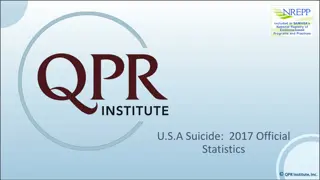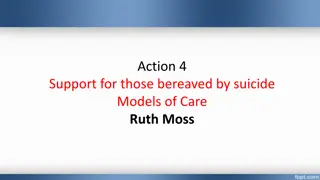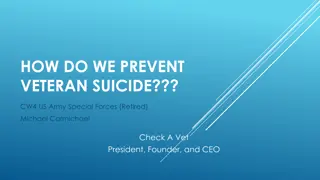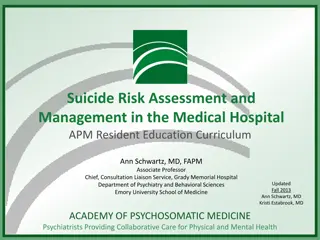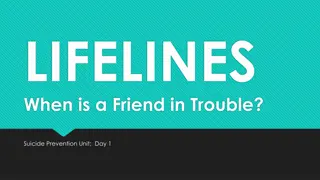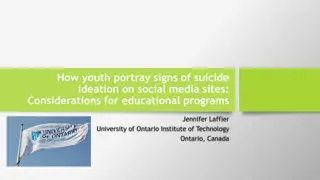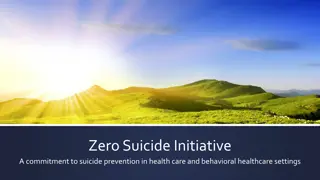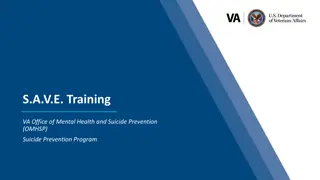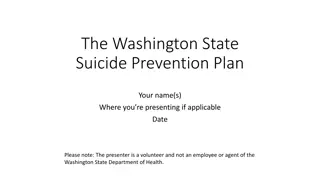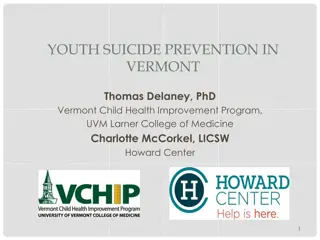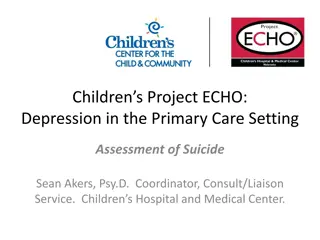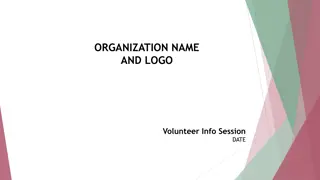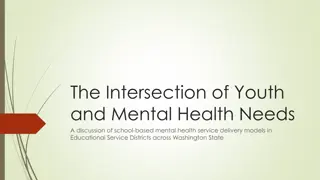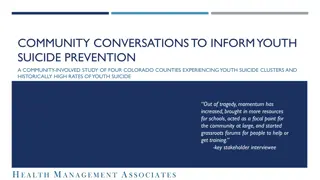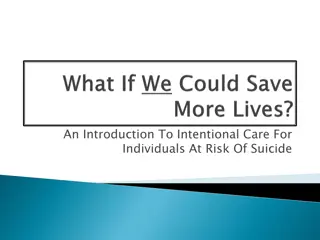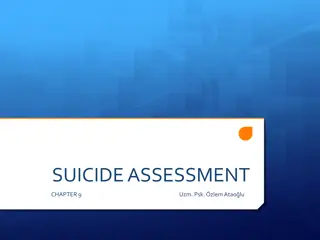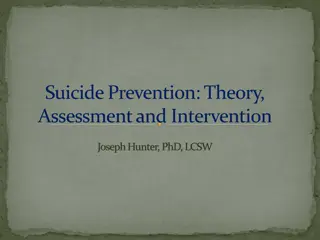Understanding Suicide Beliefs and Peer-to-Peer Support Groups
Explore beliefs about suicide and the impact on open discussions. Learn about Alternatives to Suicide peer-to-peer groups and the values and framework they uphold for mutual support. Emphasizing empathy, respect, and non-coercive approaches, these groups provide a safe space for individuals to share experiences without clinical pressures. Consider how personal beliefs affect dialogue on suicide and the importance of supportive environments in addressing mental health challenges.
Download Presentation

Please find below an Image/Link to download the presentation.
The content on the website is provided AS IS for your information and personal use only. It may not be sold, licensed, or shared on other websites without obtaining consent from the author. Download presentation by click this link. If you encounter any issues during the download, it is possible that the publisher has removed the file from their server.
E N D
Presentation Transcript
ALTERNATIVES TO SUICIDE PEER-TO-PEER GROUPS These groups have been nurtured and developed within the Western Mass Recovery Learning Community (RLC). www.westernmassrlc.org
EXAMINING OUR BELIEFS ABOUT SUICIDE
I believe suicide is okay in some situations, like when someone is terminally ill.
I believe that people should be stopped from killing themselves by any means necessary.
I believe certain thoughts and feelings are always a predictor for suicide.
I believe that people who kill themselves are selfish.
WHATDOWEBRINGTOTHETABLE? What did this exercise bring up for you? What did you learn regarding your own beliefs? How might these beliefs impact your ability to talk openly about suicide?
VALUES Self-help with focus on relationship Mutual respect, support, and empathy Non-clinical and non-coercive Instead of one expert, everyone is the expert of their own experience Respectful of each person s privacy Maintain transparency; share any limits to privacy
FRAMEWORK Mutual support group and not a clinical group or treatment program People join for as long as it suits them No red tape or hoops for anyone attending (e.g., no assessment, intake, or discharge) Facilitators openly identify with the experience of suicidal thoughts No documentation or records kept (beyond total numbers)
THE GIST People share from their own experiences Ordinary, non-medical language is used Curiosity-based vs. fear-based responses Value of meeting and accepting people as they are Willingness to sit with deep distress; not jumping to clinical interventions
FREEDOM Attendance is completely voluntary and self-determined Freedom to interpret experiences in any way Freedom to challenge social norms Freedom to talk about anything; not just thoughts of suicide
OUTOFTHE BOX No assumption of illness No assumption that suicidal thoughts are connected to mental illness Differences between suicide and self- injury are acknowledged and respected
PRACTICAL MATTERS Group meets in the community, not in a clinical setting Group open to people not using services Group open to people from other geographical areas No clinical pressure on facilitator to report back to anyone else
THECHARTERANDGUIDETOGROUPS Alternatives to Suicide Groups: mutual support groups around extreme despair and suicidal feelings Alternative Conversations Groups: adapted from Alternatives to Suicide values for provider settings that limit fuller groups
PROCESS FOR STARTING/HOLDING THE GROUP
ALTTO SUI VALUESFORNON-PEER PROVIDERS Partnership Role to avoid: Risk assessor, protector, decider, etc. Transparency Role to avoid: Secretly calling for help, keeping the individual in distress busy while someone else calls for help, pretending you are not affected by their distress, etc. Continuity Role to avoid: Seeing the individual as taken care of or no longer your problem once referred elsewhere
POSSIBLE QUESTIONS/ HELPFUL STATEMENTS What s going on? Did something happen that triggered you feeling this way? Have you felt this way before? How can I help?
POSSIBLE STRATEGIES/INTERVENTIONS Reflect and validate. Develop a plan that includes concrete steps to check in later that day and the next day, and resources to get through the next 24 hours. If in person, offer to go for a walk with the individual. Offer to call emergency services with the individual.
CONTACT US Val Neff val@namifoxvalley.org (847)337-5343 Funding for this conference was made possible by NITT-HT grant, CFDA 93.243 from SAMHSA. The views expressed in written conference materials or publications and by speakers and moderators do not necessarily reflect the official policies of the Department of Health and Human Services; nor does mention of trade names, commercial practices, or organizations imply endorsement by the U.S. Government.
